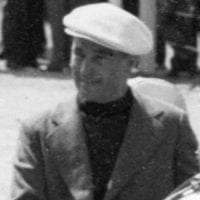One of Grand Prix racing’s leading talents of the 1930s is best remembered for his twilight years. Luigi Fagioli was a member of the all-conquering Alfa Romeo team of the 1950 and 1951 World Championships and holds a Formula 1 record that is unlikely to ever be beaten. He was 53 years and 21 days old when he shared the winning car in the 1951 French GP – the oldest driver to win a world championship race.
“The Abruzzi Robber” raced for Mercedes-Benz for three seasons from 1934 and he threatened to emerge as a true star. But his fiery temper and obstreperous character prevented that. He was a rugged competitor who forcibly (and sometimes overly so) went wheel-to-wheel with his contemporaries.
Early racing career
Trained as an accountant and already in his mid-twenties, Fagioli started racing an 1100cc Salmson voiturette in 1925 as a hobby. Success on the circuits and hillclimbs of Italy followed. That prompted him to consider racing as a profession and he joined Maserati in 1930.
A winner of more minor races, he finished second in the 1931 Monaco and 1932 Italian GPs – denied victory in the latter race by slow pit work. He defected to Scuderia Ferrari in the middle of 1933 as the semi-works team took delivery of Alfa Romeo’s “P3” Tipo-Bs. A string of victories culminated in Fagioli winning the Italian GP and being named as national champion.
Racing for Mercedes-Benz
GP racing was on the verge of revolution and Fagioli would benefit. Mercedes returned to the sport in 1934 and its legendary Team Manager Alfred Neubauer hired the Italian in case Rudolf Caracciola failed to recover from the severe injuries he had sustained practising for the 1933 Monaco GP. But rather than galvanise the team, tensions between Neubauer and Fagioli were evident from the very first day. When ordered to allow team-mate Manfred von Brauchitsch to win the Eifelrennen on their debut, Fagioli simply parked his car and stormed away.
His petulance was matched by his outright speed however. Fagioli finished second in the German GP before winning the Coppa Acerbo, Italian GP (sharing Caracciola’s car) and Spanish GP. 1935 began with further victories at Monaco, Avus and in Barcelona’s Montjuich Park but his temperament would soon clash again with the team’s Teutonic precision.
He ignored Neubauer’s instructions during the Belgian GP and was replaced by the more compliant von Brauchitsch at a pitstop. He remained for one more unsatisfactory season as Mercedes struggled with its uncompetitive W25C chassis in 1936.
Brief Auto Union career
Frustrated by Caracciola’s pre-eminent place in the team, Fagioli considered retirement but moved to Auto Union in 1937. That did not stop him clashing with his former team-mate once more. He beat Caracciola into fifth position in Tripoli but was furious at having been baulked throughout the race. Fagioli stormed into the Mercedes pit after the race and threw a wheel hammer at Caracciola before snatching a knife only to be restrained by Neubauer and mechanic Wilhelm Sebastian!
Formula 1 with Alfa Romeo
Forced to retire from racing soon afterwards due to his worsening rheumatism, his health improved and Fagioli made a comeback 10 years later. He returned to GP racing with Alfa Romeo in 1950 and the team dominated proceedings with Giuseppe Farina and Juan Manuel Fangio trading victories. Outpaced by younger team-mates, Fagioli finished second on four occasions to finish third in the inaugural world championship.
His only GP of 1951 was in France and he was the slowest of the four Alfa Romeo 159s entered. He was running in the top three despite a spin when he handed over to Fangio whose own car was suffering from a faulty magneto. The Argentinian took the lead on lap 51 and won by almost a minute.
Sports cars with Lancia
Unhappy to have been told to relinquish his car, that was Fagioli’s last championship GP but he was third in the 1952 Mille Miglia for Lancia. That he beat Caracciola that day will no doubt have been deeply satisfying to the burly veteran.
The 1952 Monaco GP was a sports car race and Fagioli was a star attraction for a race he had won 17 years earlier. But his Lancia Aurelia crashed exiting the tunnel during practice and Fagioli suffered a broken arm and leg. Unconscious for four days, little suggested that his life was in danger but he had also suffered internal injuries and he died in hospital three weeks later.


